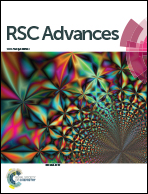Novel g-C3N4/BiIO4 heterojunction photocatalysts: synthesis, characterization and enhanced visible-light-responsive photocatalytic activity
Abstract
The g-C3N4/BiIO4 composite photocatalysts were successfully synthesized using a simple-mixed-calcinations method, and their photocatalytic activities for degradation of rhodamine B (RhB) under visible-light (λ > 420 nm) were investigated for the first time. The crystal structure and optical property of the as-synthesized samples were characterized by XRD, FTIR, SEM, TEM, HRTEM and DRS spectroscopy. The photodegradation experiments indicated that the g-C3N4/BiIO4 composite photocatalyst displays a higher photocatalytic activity than the two individuals, which was also confirmed by the PL spectra and photoelectrochemical experiments. This remarkably improved photocatalytic performance can be attributed to the heterojunction structure of g-C3N4/BiIO4 composites, which possess stronger oxidation and reduction capability, thus resulting in the efficient separation of photoinduced charge carriers as demonstrated in the active species experiments. The present study will be beneficial for the design of high performance photocatalysts.


 Please wait while we load your content...
Please wait while we load your content...